Shopify is among the most popular and successful eCommerce platforms available and it’s no accident. It offers powerful, user-friendly features as well as seamless processing for e-commerce shops of all types. However, just like everything else, it is important to understand the particulars of each eCommerce platform before choosing the best one for your business. So, let’s take a closer look at Shopify.
What Is Shopify?
Shopify is an online marketplace that permits nearly every business to establish an online shop or an in-person store to sell their merchandise. Additionally, Shopify is an ideal platform for different vendors to market and sell their products and services.
Shopify currently helps hundreds of thousands of entrepreneurs across 175 nations get their venture on the right track. The platform houses more than 1 million companies, and is the third-largest retail site in the United States, only falling just short of Amazon or eBay.
Is Shopify Good for SEO?
Shopify has proven its value to companies around the world, but it also has SEO issues. In the realm of online shopping, search engine optimization plays a crucial part in how successful the business is, as websites that rank higher appear more prominently on search engine result webpages (SERP).
Shopify could have some problems with SEO in the same as Squarespace and BigCommerce are both plagued by SEO issues. They operate with a restricted platform that is hard for the average Internet user to modify. It is because users can’t simply access the website’s back-end and make modifications to enhance SEO value.
For instance, sitemaps are generated automatically and cannot be edited, and difficult to edit forced URL structure. We delve deeper into some common Shopify SEO issues below.
9 Common Shopify SEO Issues and How You can Fix Them Now
First, what exactly does Shopify SEO mean? It’s exactly what you imagine it to be. Shopify SEO is nothing more than optimization for a search engine that is designed specifically for the Shopify store. While you are able to create blogs and enhance your SEO using other integrated tools, it could also bring out a variety of Shopify SEO problems. What you must be aware of are:
- Implementing canonical URLs
- Automatic breadcrumb navigation
- No custom tag pages
- Duplicate content
As you can see, these common Shopify SEO issues are a lot to do with the tech SEO aspect. We’ll provide suggestions for dealing with these Shopify SEO issues later.
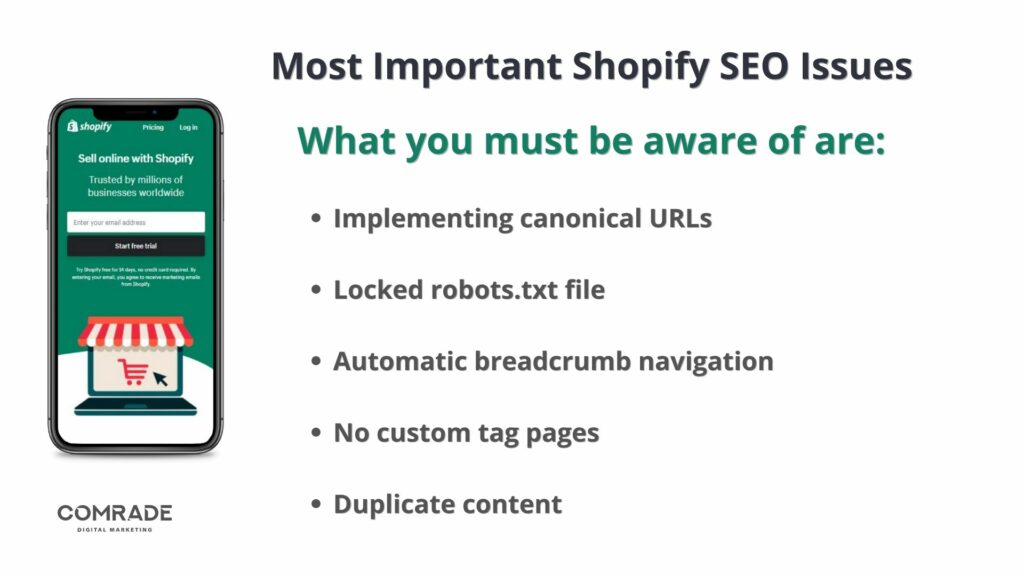
1. Canonical URLs for Shopify Online Store

Canonical URLs comprise the HTML component that makes up the element link. A canonical URL allows Google (and the other engines) to search the page and arrange it in a way that is appropriate. If there’s an issue with the canonical URL, duplicates of identical content are transmitted to Google, which may cause harm to SEO.
For instance, the product URLs below are all very similar, and Google could not determine which is most relevant.
Problem
Canonical URL issues are related to the same pages, which are accessible through multiple URLs. Although Shopify has a redirecting tool, it won’t function effectively if the site you’re trying to use it for already exists. Furthermore, those who aren’t familiar with SEO are likely to struggle to figure out the most efficient way to get the results they’d like.
Solution
The good news is that this is a relatively simple problem to solve. Making a small change to your Shopify theme file is all that is necessary. Here’s how to solve the problem:
- Choose Online Store => Shopify Themes from the left sidebar
- Find the Actions button => Edit the code
- Locate “product-grid-item.liquid” in the “Snippets” folder and click on it
- Change this default code: <a href=”{{ product.url | within: current collection }}” class=”product-grid-item”>
- Replace with following code: <a href=”{{ product.url }}” class=”product-grid-item”>
By making this change to the code, you can be sure that any links you have to product pages will now use the proper URL path.
2. Breadcrumb URLs

When done right, a navigation system can simplify the steps a user must take to get to a more complex page. However, another Shopify SEO problem is the way it generates breadcrumb URLs for items within the same category.
Problem
Sometimes Shopify can have serious issues with the breadcrumb URL. For example, category positions may be confused. The resulting breadcrumb might look like this: Black > Women’s Clothing > Store > Skirts.
As you can see, the categories are completely wrong, which will make it harder for search engines to index your pages. In addition to having a terrible effect on the indexing of your pages, it also affects the user experience. As a result, many potential customers simply leave your site due to such confusing navigation.
Solution
Before you start fixing the problem, you first need to find the part of the code where you have the error. The easiest way to do this is to use the Google Search Console, where you are most likely already notified of the breadcrumb issue. Click on the notification, then click on Fix Breadcrumb Issues. As soon as you click on the button, you will see the code highlighted in red, which contains the error.
Now that you know where the error is in the code, you can fix it. Let’s break it down step by step on how to do it:
- Head over to your Shopify Admin
- Go to Online Store => Themes
- Select Action => Edit Code
- Find the “Snippets” section => Select “collection-template.liquid”
- Add Position For Each Item
In order to make it easier for you to understand, take a look at an example from Google of exactly what your BreadcrumbList should look like:
3. Sitemap Issues

XML sitemaps are one of the most significant elements of SEO because, without them, search engines won’t be able to crawl your Shopify sites efficiently, let alone index many of your pages. Nevertheless, you shouldn’t worry since, unlike other platforms, Shopify generates an XML sitemap for your website whenever a new page is added. Additionally, occasionally, not all pages are indexed, in which case you need to manually create a new Sitemap.
Problem
Keep in mind that if you don’t submit your sitemap to Google or other search engines, you run the risk of not indexing every page of your site. This is especially true for new stores where Google hasn’t fully crawled and indexed your website.
Solution
In order to improve the visibility of your site in search engines, it is necessary to create a Google Webmaster account and periodically submit an XML sitemap to Google and resolve this issue. This way, Google will crawl your site again for new and default pages and index them. Here are a few steps you should follow to get a better chance of getting your pages indexed:
- Open Google Webmaster Console and log in.
- Select the URL of your website.
- Select the Crawl link in the menu of Webmaster Tools Console, then click Sitemaps.
- In the upper right corner, click Add/Test Sitemap.
- Try entering sitemap.xml at this point.
- Go to submit the sitemap to send it to Google.
That’s all. Now your pages will definitely be indexed. However, it may take a few days, so don’t be discouraged if you don’t see results right away.
4. Tag Pages on Shopify
Every user-friendly website must be organized in the back end, and the simplest way to do this is to use tags. Tags aren’t just an easy way to organize the contents of a Shopify store but also aid users in identifying the items they’re searching for on your website.
Problem
Shopify automatically produces a new page under each collection that is applied for each product tag in your store. Consider a product tag called women clothes that is applied to products from 8 different collections. This will automatically create 8 different pages, but they cannot be customized. Moreover, all of them will have the same text. Here’s where such a problem leads in, take a look at these Google search results:
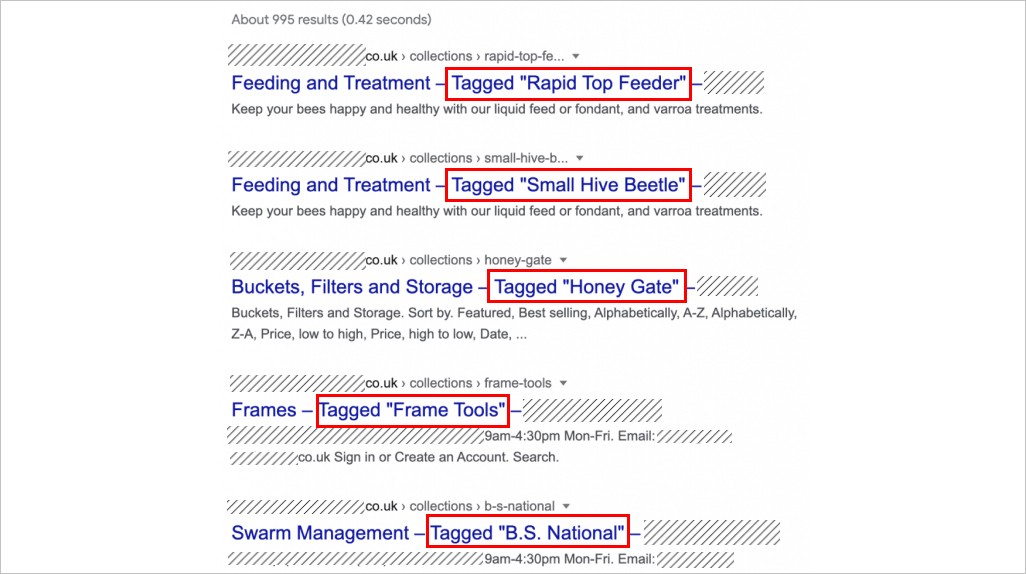
Except for the filtered goods, you can see that these pages are an exact copy of the main collection. Consequently, each of these tag pages has a duplicate H1, collection description, information, meta description, and everything else that is important for SEO. As a result, search engines may believe that you are just stealing information from other websites, which is highly negative for your website’s SEO.
Solution
In order to add content, there are two options:
- Change Your Shopify Theme: The Shopify platform comes with fixed themes that you can change to customize. If you wish to add content to specific pages – a code has to be included. Additionally, this tag should be added to any page that requires customization, which is a lengthy and laborious procedure.
- Get an application for Shopify: There’s a myriad of add-ons and apps that you can install on your Shopify website. However, they do not have any of the most current applications or add-ons that allow users to edit the pages completely. Moreover, the extra apps could slow the speed of your website.
A lot of Shopify users aren’t familiar with the use of tag pages. This is yet another obstacle to overcome.
5. Image Alt Text
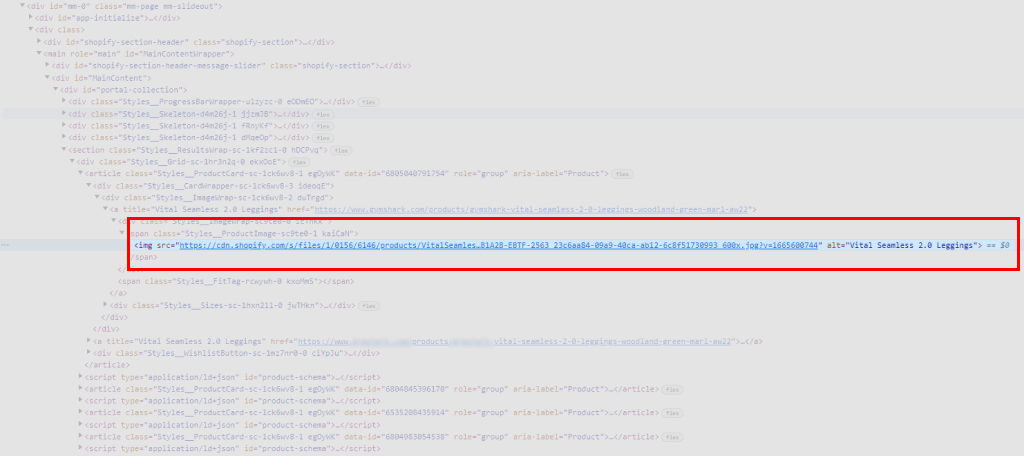
Despite the rapid development of search engines, they still cannot describe an image by its pixels alone. This is why it is so important for a Shopify store to describe product images, as this information makes it easier for search engines to analyze your pages, leading to higher search engine rankings.
Problem
When adding any image to Shopify, you should have no problem adding text to the “alt” attribute. However, there are exceptions: some images are embedded in your theme files or are part of a custom element in your Shopify store, such as sliders, sidebars, and so on. Due to the inability to simply add a description to them, these page elements create many problems for online business operators.
Solution
- Click on the Online Store button
- Select Themes from the left-hand sidebar
- Click on the Actions button => Edit the code
- Find the <img> HTML element with the “alt” attribute
- Write text describing the image in “alt”
- Save the file
Remember that your descriptions shouldn’t look like spam, so it’s best to describe the image and insert your main keyword at least once in that description field. The more often keywords appear in the description of images, the easier it will be for search engines to find your site.
6. Title Tag Issues

Since visitors usually choose eCommerce sites based on their page titles, title tags are really essential. Meta titles should not only catch the customer’s eye but should also be optimized for SEO purposes, which calls for using the keywords that prospective customers are most likely to search for. However, there is a problem, even if you want to make a title with the maximum number of keywords, you will fail because Shopify only allows 70 characters in the title, which is definitely a huge problem for Shopify store owners.
Problem
In order to avoid running out of space on the screen, it is not recommended to use the entire available character limit. Even though it may sound a little snobbish to you, it actually directly affects how good a site looks on search engine results pages. The main problem of some stores is that they often go too far, using the maximum number of characters.
Solution
The preview at the bottom of the page may be the best solution for businesses that wish to put all of the information they can about the product in one title. Store owners can use this feature to test how the title will be displayed to site visitors. This will allow them to choose the most suitable headline that will display the useful information about the product and won’t be too long.
7. Shopify SEO Limitations for Meta Description
Meta descriptions let visitors know what your page will cover before they open your site. Google generally uses the width of a pixel to determine the amount of text that should be displayed in meta descriptions. However, Shopify employs character limitations to define the length the meta data can be.
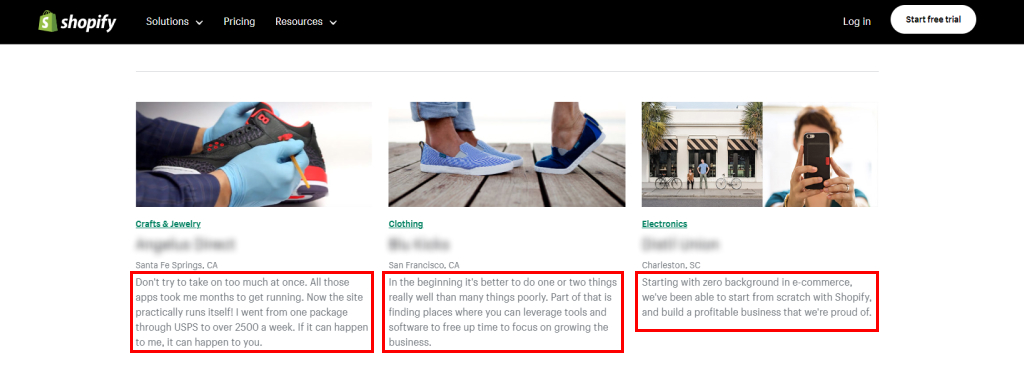
Problem
The character limit is a real problem, especially when you have your desired page meta description in mind, but it ends up being too long. The process of editing the text isn’t an issue, but it is a minor problem that becomes more annoying as time passes.
Solution
This issue has a straightforward remedy. You just need to be careful when writing meta descriptions- accurately select keywords and keep track of the number of characters written. Once you publish product information with a page meta description, Google will index your page and display it in search results. The better the meta description matches the needs of your potential buyers, the more likely your site will be on the first page of search results.
8. Blog Problem
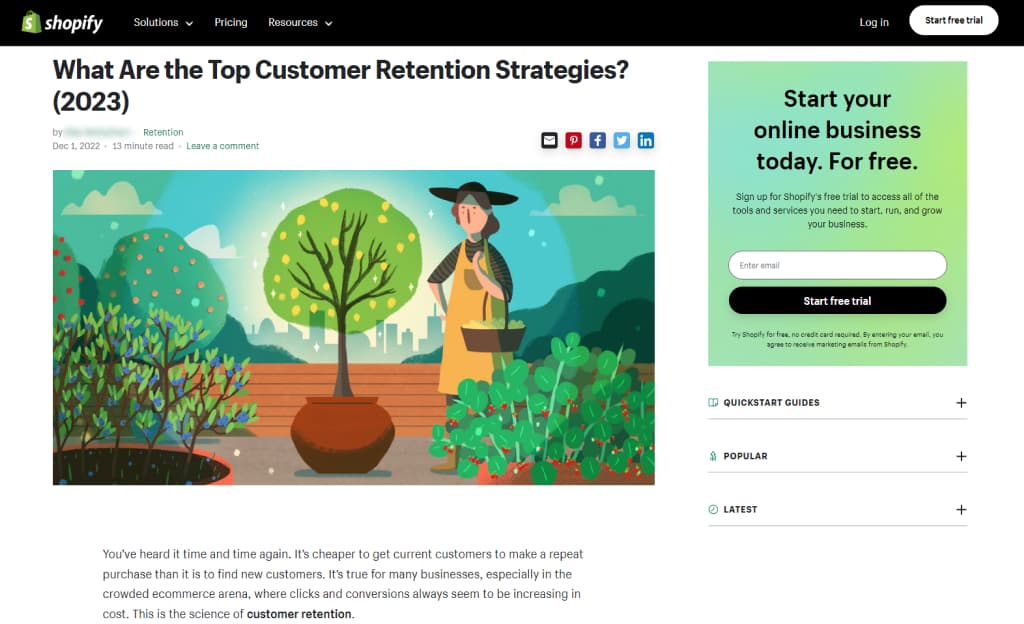
Content marketing is an essential element of any brand that is successful, even those who are just beginning their journey with Shopify. However, Shopify comes with many restrictions that make it incapable of being a robust blog platform.
Problem
The main problem with Shopify is that the home page is the only place you can use dynamic sections (which allow you to customize pages with content). Due to its inflexibility, this platform isn’t designed for content-driven companies that require customization outside of their homepage.
Solution
Finding a solution to this problem is not easy, but it is possible. The best way is to install WordPress. With it, you can safely write new posts on various pages and not think about the markup on the site because everything will already be optimized for your website. However, WordPress and Shopify cannot exist on the same domain. Therefore, you need to create a separate subdomain where your blog will be located. As a result, you are in the black everywhere. Now you can enjoy the benefits of both WordPress and Shopify!
Learn about more ways to improve WordPress SEO.
9. Duplicate Content
A major and frequent Shopify SEO problem is duplicate content. Duplicate content refers to multiple variations of the exact content that are associated with different URLs. If the same content is featured many times, it can affect search results. Additionally, Google may not know what content to highlight and what to hide, which could negatively impact websites.
Problem
The issue with product tags on Shopify is related to the duplicate content issue. Since tags are used to organize certain Shopify items, separate pages that have to be indexable. These pages will display identical content to that found on the collection pages producing duplicate content.
Solution
To prevent this problem from occurring, Shopify users will have to manually de-index their tags. However, it is also possible to add tags with content only when you are able to navigate Shopify correctly.
Can You Get Good Search Engine Results on Shopify?
As the world is becoming more digital, it’s essential for businesses, big as well as small to develop an appropriate SEO strategy that will allow them to grow and thrive. However, Shopify’s SEO issues have users having difficulties in doing this which ultimately impacts the brand’s growth.
SEO services are one aspect of marketing via digital channels that could quickly become a chore and overwhelming particularly for new Shopify customers who have been trying to get their site and brand up and running, but not contemplating how to get in the first position on Google’s page of results.
While it’s possible to work over certain SEO barriers that Shopify provides, it requires a substantial cost for Shopify sellers.

Comrade Can Solve All Your Shopify SEO Problems
If you’re seeking advice from experienced SEO professionals – our group of experts at Comrade can walk you through the most important features that are part of Shopify as well as SEO for e-commerce. These aspects will affect your business. We are not only experts in and are knowledgeable about SEO however, but we also have a specialization in helping brands expand their reach through Shopify modifications. Our team can assist you with Shopify website development and SEO issues so that you can concentrate on what you are best at. Contact us now, and we’ll be happy to give you a complete assessment at no cost. It’s as easy as that.
Learn more about how to choose an SEO agency.




